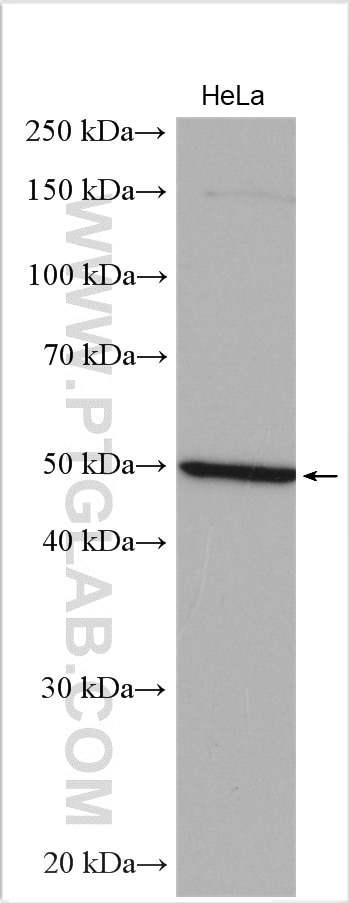TBX15 Polyclonal antibody
TBX15 Polyclonal Antibody for WB, ELISA
Host / Isotype
Rabbit / IgG
Reactivity
human and More (1)
Applications
WB, ELISA
Conjugate
Unconjugated
Cat no : 25148-1-AP
Synonyms
Validation Data Gallery
Tested Applications
| Positive WB detected in | HeLa cells |
Recommended dilution
| Application | Dilution |
|---|---|
| Western Blot (WB) | WB : 1:1000-1:8000 |
| It is recommended that this reagent should be titrated in each testing system to obtain optimal results. | |
| Sample-dependent, Check data in validation data gallery. | |
Published Applications
| WB | See 1 publications below |
Product Information
The immunogen of 25148-1-AP is TBX15 Fusion Protein expressed in E. coli.
| Tested Reactivity | human |
| Cited Reactivity | human, mouse |
| Host / Isotype | Rabbit / IgG |
| Class | Polyclonal |
| Type | Antibody |
| Immunogen | TBX15 fusion protein Ag18423 |
| Full Name | T-box 15 |
| Calculated Molecular Weight | 602 aa, 66 kDa |
| Observed Molecular Weight | 50 kDa |
| GenBank Accession Number | BC122553 |
| Gene Symbol | TBX15 |
| Gene ID (NCBI) | 6913 |
| RRID | AB_2879924 |
| Conjugate | Unconjugated |
| Form | Liquid |
| Purification Method | Antigen affinity purification |
| Storage Buffer | PBS with 0.02% sodium azide and 50% glycerol pH 7.3. |
| Storage Conditions | Store at -20°C. Stable for one year after shipment. Aliquoting is unnecessary for -20oC storage. 20ul sizes contain 0.1% BSA. |
Background Information
TBX15 is a transcription factor from the T-box family and is a highly pleiotropic gene expressed in multiple tissues at different stages of development. It is required for skeletal development and deletions in this gene cause severe skeletal malformation. In addition, TBX15 also plays a role in the differentiation of brown and beige adipocytes (PMID: 28007980). The predicted molecular weight of TBX15 is 66 kDa. With modification, the MW of TBX15 will be migrated to 50 kDa.
Protocols
| Product Specific Protocols | |
|---|---|
| WB protocol for TBX15 antibody 25148-1-AP | Download protocol |
| Standard Protocols | |
|---|---|
| Click here to view our Standard Protocols |
Publications
| Species | Application | Title |
|---|---|---|
iScience TBX15 facilitates malignant progression of glioma by transcriptional activation of TXDNC5 |


